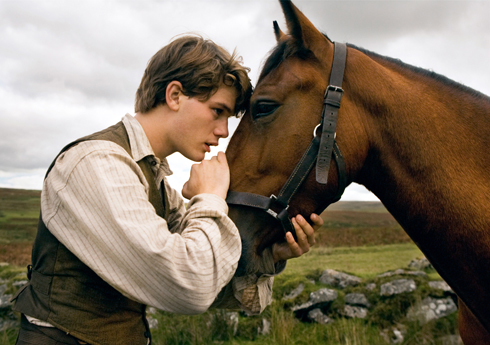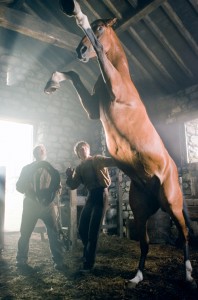Whirled at War
By Staff Report December 24, 2011
Albert (Jeremy Irvine) bonds with his farm horse, Joey, in the WWI drama War Horse. (Photo by Andrew Cooper / Dreamworks)
They served on the front lines, the back lines and everything in between. The horse in war was an indispensible partner, and an estimated eight million of them died in WWI. “The soldier came to regard his horse almost as an extension of his being,” wrote J.M. Brereton in his book The Horse in War. Director Steven Spielberg brings the intensity of that relationship to the screen on December 25 with War Horse. Based on Michael Morpurgo’s 1982 young adult novel, the tale unfolds a la Black Beauty, through the eyes of a ‘mane’ character.
Joey, a farm horse enjoying a peaceful country life with his young owner Albert, is suddenly scooped up by a British Cavalry girding for WWI.
The story plays out across the battlefields of England, France and Germany following Joey’s life journey and then Albert’s search to find him. “I thought the story was absolutely fascinating, and I was transported,” Spielberg said in the early stages of publicity on the movie. “In my mind, it was very honest ― the journey of a boy and a horse who were once so close, whose destinies drive them far apart. I hope this story will bring people together through this shared experience; its heart and its message can be felt in every country.”
The novel, released in the U.S. by Scholastic, sprang to prominence only after being adapted for the stage with life-sized equine puppets in the lead roles. For the film, Spielberg opted for reality over the fantasy of puppets and computer effects; real horses were cast, and coaxing performances out of them fell to wrangler Bobby Lovgren of Acton.

Wrangler Bobby Lovgren trains Finder, a Thoroughbred who was one of the main doubles for Joey, at his facility in Acton, CA.
A veteran whose resumé includes Cowboys and Aliens, Seabiscuit and The Legend of Zorro, Lovgren’s primary task was training Joey and his trench buddy Topthorn. There were 10 horses that contributed to Joey’s performance, and another four for Topthorn. The bigger battle scenes featured between 100 and 150 horses in the background, and there were two assistant directors focused exclusively on the animal actors.
Because the film was shot in England, that’s where the mounts were acquired. A three-month prep window, while typical on feature films, seemed woefully compressed on such a complicated project. Lovgren was able to leverage many years of training by bringing in his own horse, Finder, for many of the key performances by Joey. The 11-year-old blood bay Thoroughbred gelding was one of two horses Lovgren trained for Seabiscuit, “and I wound up buying him. Since then, he has done many films with me, so I’ve put in a lot of time on specialty training.”
Lovgren says that on every film he works on, the primary challenge is getting horses to “act.” But on this film there was a lot of acting. “Much more emotion was required of the animals, and that’s the difficulty, capturing those feelings.”
Spielberg described the opportunity to work with horses as thrilling. “I was really amazed at how expressive horses are and how much they can show what they’re feeling,” said Spielberg, noting that members of his family, including wife Kate Capshaw and two daughters, ride.

Finder was specifically trained for liberty scenes that involved exuding emotion while keeping calm. (Photo by Andrew Cooper / Dreamworks)
Finder, Lovgren explains, is “not an easy horse. He’s not a good actors’ riding horse, and no actor’s ever ridden him. That’s not what I have him for. He’s good at playing a wild horse ― great at playing wild and frightened. He can be so contained and yet look like he’s panicking.”
In other words, an actor’s actor! “Because he’s a Thoroughbred, and kind of lean, we can use him to play different ages with a little help from makeup and lighting. We used him to play Joey as a two-year-old, and also as a mature horse.
Because the plot revolves largely around the mayhem of war, the horses spend a lot of time conveying fear. “Obviously you want the horse to look scared, but not to be scared, because a frightened horse is not a safe horse. Happy, sad, glad – these things are sometimes conveyed by the movement of the ear.”
Makeup, he says, “was huge. The horses had to be made up every day, to look alike when they were doubling, and to have all the mud applied for the war sequences.” Basically, healthy well-cared- for horses had to undergo a “make-under” to appear scraggly and battle-worn.”
But the biggest challenge, Lovgren says, was working with foals. “We depict this horse’s life from birth, and in fact, there is a birthing scene, which we shot here in L.A. with a horse that was only three weeks old.” With foals, “you have a two- to three-week window, because they grow fast. You have to have a few of them, so they don’t get stressed. Then you have mom looking over your shoulder. She needs to be there so the baby can eat. It’s a lot of pressure!”
For more information, visit www.WarHorseMovie.com. To read a London Evening Standard interview with author Michael Murpurgo, click here.
Short URL: https://theequestriannews.com/?p=6915


